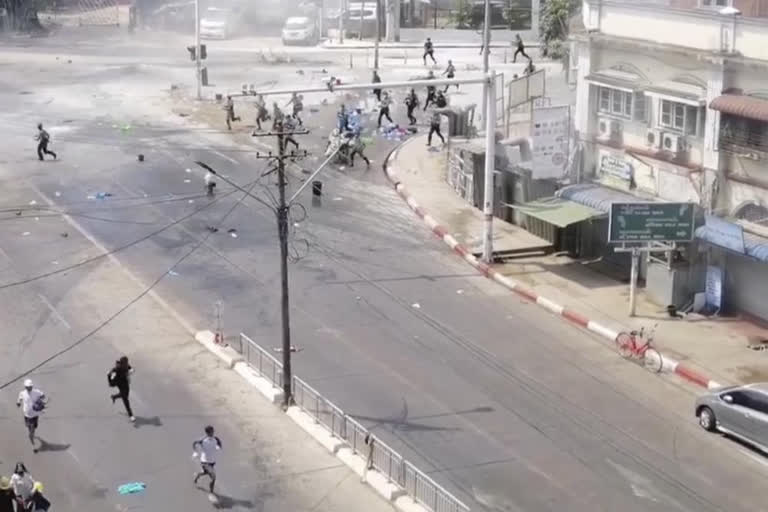Jakarta: The soldiers in rural Myanmar twisted the young man's skin with pliers and kicked him in the chest until he couldn't breathe. Then they taunted him about his family until his heart ached, too: Your mom, they jeered, cannot save you anymore. The young man and his friend, randomly arrested as they rode their bikes home, had been subjected to hours of agony inside a town hall transformed by the military into a torture center. I'm going to die, the young man told himself, stars exploding before his eyes. I love you, mom.'
Since its takeover of the government in February, the Myanmar military has been torturing those it has detained in a methodical and systemic way across the country, The Associated Press has found in interviews with 28 people imprisoned and released in recent months. Based also on photographic evidence, sketches and letters, along with testimony from two military captains and an aide to a high-ranking commander, the AP investigation provides the most comprehensive look since the takeover into a secretive detention system that has held more than 9,000 people.
While most of the torture has occurred inside military compounds, the military, known as the Tatmadaw, has also transformed public facilities such as community halls into interrogation centers, prisoners said. The AP identified a dozen interrogation centers in use across Myanmar, in addition to prisons and police lockups. The prisoners interviewed came from every corner of the country, and ranged from a 16-year-old girl to monks. Some were detained for protesting against the military, others for no discernible reason. Multiple military units and police were involved in the interrogations, their methods of torture similar across Myanmar.
The Myanmar military has a long history of torture, particularly before the country began transitioning toward democracy in 2010. While torture in recent years was most often recorded in ethnic regions, its use has now returned across the country, AP's investigation found. The vast majority of torture techniques described by prisoners were similar to those of the past, including electric shocks, near-drownings and relentless beatings. But this time, the torture is the worst it's ever been in scale and severity, according to the Assistance Association for Political Prisoners, which monitors deaths and arrests. Since February, the group says, security forces have killed more than 1,200 people, including at least 131 detainees tortured to death.
The military tortures detainees, first for revenge, then for information, says Ko Bo Kyi, AAPP's joint secretary and a former political prisoner. I think in many ways the military has become even more brutal. The military has also taken steps to hide evidence that it has tortured prisoners, with several prisoners saying interrogators brutalized only the parts of their bodies that could be hidden by clothes. An aide to the highest-ranking army official in western Myanmar's Chin state told the AP that soldiers covered up the deaths of two tortured prisoners, forcing a military doctor to falsify their autopsy reports.
Also read: Myanmar's Suu Kyi pleads not guilty to breaking virus rules
A former army captain who defected from the Tatmadaw in April confirmed to the AP that the military's use of torture against detainees has been rampant since its takeover. In our country, after being arrested unfairly, there is torture, violence and sexual assaults happening constantly, says Lin Htet Aung, the former captain. After receiving detailed requests for comment, military officials responded with a one-line email that said: We have no plans to answer these nonsense questions. All but six of the prisoners interviewed by the AP were subjected to abuse, including women and children. Most of those who weren't abused said their fellow detainees were.
The AP also sent photographs of several torture victims' injuries to a forensic pathologist with Physicians for Human Rights. The pathologist concluded wounds on three victims were consistent with beatings by sticks or rods. You look at some of those injuries where they're just black and blue from one end to the other, says forensic pathologist Dr. Lindsey Thomas. This was not just a swat. This has the appearance of something that was very systematic and forceful. Photographs taken inside several detention and interrogation facilities confirmed prisoners' accounts of overcrowded, filthy conditions. Most inmates slept on concrete floors, packed like sardines.
Some became sick from drinking dirty water only available from a shared toilet. Cockroaches swarmed their bodies at night. There was little to no medical treatment. Not even the young have been spared. One woman was imprisoned alongside a 2-year-old baby. The interrogation centers were worse than the prisons, with nights a cacophony of weeping and wails of agony. It was terrifying, my room, one man recalls. There were blood stains and scratches on the wall.
Back inside the rural town hall, the young man and his friend survived the night amid a haze of pain. When dawn came, the interrogators sent them to prison. Their small cell was home to 33 people. They lay next to the lone squat toilet. Their fellow inmates shared water and biscuits, though the young man's mouth was too torn apart to eat.
Also read: ASEAN downgrades Myanmar presence in summit in major rebuke
After two days, the families of the young man and his friend paid officials to get them out of prison. Both men were forced to sign statements saying they had participated in a demonstration and were anti-police. For two months, his entire body ached. Even today, his right shoulder stomped on by a soldier won't move properly. After they caught us, I know their hearts and their minds were not like the people's, not like us, he says. They are monsters.
AP



